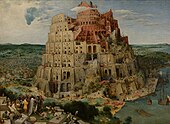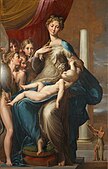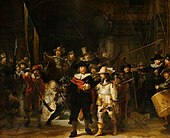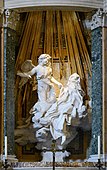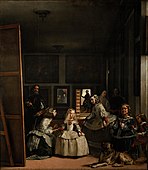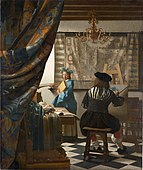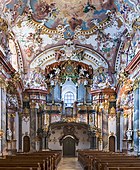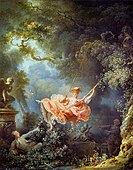Art of Europe
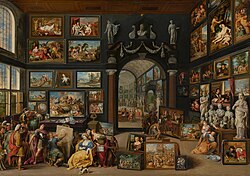


| History of art |
|---|
| European art history |
|---|
|
The art of Europe, also known as Western art, encompasses the
The influence of the art of the
Before the 1800s, the Christian church was a major influence on European art, and commissions from the Church provided the major source of work for artists. In the same period there was also a renewed interest in classical mythology, great wars, heroes and heroines, and themes not connected to religion.[6] Most art of the last 200 years has been produced without reference to religion and often with no particular ideology at all, but art has often been influenced by political issues, whether reflecting the concerns of patrons or the artist.
European art is arranged into a number of stylistic periods, which, historically, overlap each other as different styles flourished in different areas. Broadly the periods are,
Prehistoric art
European prehistoric art is an important part of the European cultural heritage.[7] Prehistoric art history is usually divided into four main periods: Stone Age, Neolithic, Bronze Age, and Iron Age. Most of the remaining artifacts of this period are small sculptures and cave paintings.
Much surviving
The oldest European cave art dates back 40,800, and can be found in the
The Rock art of the Iberian Mediterranean Basin represents a very different style, with the human figure the main focus, often seen in large groups, with battles, dancing and hunting all represented, as well as other activities and details such as clothing. The figures are generally rather sketchily depicted in thin paint, with the relationships between the groups of humans and animals more carefully depicted than individual figures. Other less numerous groups of rock art, many engraved rather than painted, show similar characteristics. The Iberian examples are believed to date from a long period perhaps covering the Upper Paleolithic, Mesolithic and early Neolithic.
Prehistoric
-
Montignac, Dordogne, France)
-
Bison Licking Insect Bite; 15,000–13,000 BC; antler; National Museum of Prehistory (Les Eyzies-de-Tayac-Sireuil, France)
-
TheNational Museum of Romanian History (Bucharest)
-
Female figure; by Vinča culture from Serbia; 4500-3500 BC; fired clay with paint; overall: 16.1 cm; Cleveland Museum of Art (Ohio, US)
Ancient
Minoan
The Minoan civilization of Crete is regarded as the oldest civilization in Europe.[15] Minoan art is marked by imaginative images and exceptional workmanship. Sinclair Hood described an "essential quality of the finest Minoan art, the ability to create an atmosphere of movement and life although following a set of highly formal conventions".[16] It forms part of the wider grouping of Aegean art, and in later periods came for a time to have a dominant influence over Cycladic art. Wood and textiles have decomposed, so most surviving examples of Minoan art are pottery, intricately-carved Minoan seals, .palace frescos which include landscapes), small sculptures in various materials, jewellery, and metalwork.
The relationship of Minoan art to that of other contemporary cultures and later
Minoan art has a variety of subject-matter, much of it appearing across different media, although only some styles of pottery include figurative scenes. Bull-leaping appears in painting and several types of sculpture, and is thought to have had a religious significance; bull's heads are also a popular subject in terracotta and other sculptural materials. There are no figures that appear to be portraits of individuals, or are clearly royal, and the identities of religious figures is often tentative,[19] with scholars uncertain whether they are deities, clergy or devotees.[20] Equally, whether painted rooms were "shrines" or secular is far from clear; one room in Akrotiri has been argued to be a bedroom, with remains of a bed, or a shrine.[21]
Animals, including an unusual variety of marine fauna, are often depicted; the "
While Minoan figures, whether human or animal, have a great sense of life and movement, they are often not very accurate, and the species is sometimes impossible to identify; by comparison with
-
Kamares ware beaked jug; 1850-1675 BC; ceramic; height: 27 cm; from Phaistos (Crete, Greece); Heraklion Archaeological Museum (Greece)
-
The Malia Pendant; 1800-1700 BC; gold; height: 4.6 cm, width: 4.9 cm; Heraklion Archaeological Museum
-
The fresco named the Bull-Leaping Fresco; 1675-1460 BC; lime plaster; height: 0.8 m, width: 1 m; from the palace at Knossos (Crete); Heraklion Archaeological Museum
-
"Snake Goddess" figurine; 1460-1410 BC (from the Minoan Neo-palatial Period); faience; height: 29.5 cm; from the Temple Repository at Knossos; Heraklion Archaeological Museum
Classical Greek and Hellenistic
-
The Euphiletos Painter Panathenaic prize amphora; 530 BC; painted terracotta; height: 62.2 cm; Metropolitan Museum of Art (New York City)
-
Mirror with a support in the form of a draped woman; mid-5th century BC; bronze; height: 40.41 cm; Metropolitan Museum of Art
-
The Grave relief of Thraseas and Euandria; 375-350 BC; Pentelic marble; height: 160 cm, width: 91 cm; Pergamon Museum (Berlin)
-
Volute krater; 320-310 BC; ceramic; height: 1.1 m; Walters Art Museum (Baltimore, US)
-
Statuette of a draped woman; 2nd century BC; terracotta; height: 29.2 cm; Metropolitan Museum of Art
-
Venus de Milo; 130–100 BC; marble; height: 203 cm (80 in); Louvre
-
Mosaic which represents the Epiphany ofArcheological Museum of Dion
-
Illustrations of examples of ancient Greek ornaments and patterns, drawn in 1874
Roman
Roman art was influenced by Greece and can in part be taken as a descendant of ancient Greek painting and sculpture, but was also strongly influenced by the more local Etruscan art of Italy. Roman sculpture, is primarily portraiture derived from the upper classes of society as well as depictions of the gods. However, Roman painting does have important unique characteristics. Among surviving Roman paintings are wall paintings, many from villas in Campania, in Southern Italy, especially at Pompeii and Herculaneum. Such painting can be grouped into four main "styles" or periods[26] and may contain the first examples of trompe-l'œil, pseudo-perspective, and pure landscape.[27]
Almost all of the surviving painted portraits from the Ancient world are a large number of
-
Bronze statuette of a philosopher on a lamp stand; late 1st century BC; bronze; overall: 27.3 cm; weight: 2.9 kg; Metropolitan Museum of Art (New York City)
-
Restoration of a fresco from an Ancient villa bedroom; 50-40 BC; dimensions of the room: 265.4 x 334 x 583.9 cm; Metropolitan Museum of Art (New York City)
-
Calyx-krater with reliefs of maidens and dancing maenads; 1st century AD; Pentelic marble; height: 80.7 cm; Metropolitan Museum of Art
-
Panoramic view of the Pantheon (Rome), built between 113 and 125
-
Head of a goddess wearing a diadem; 1st–2nd century; marble; height: 23 cm; Metropolitan Museum of Art
-
Couch and footstool; 1st–2nd century AD; wood, bone and glass; couch: 105.4 × 76.2 × 214.6 cm; Metropolitan Museum of Art
-
Sarcophagus with Apollo, Minerva and the Muses; circa 200 AD; from Via Appia; Antikensammlung Berlin (Berlin)
-
Sarcophagus with festoons; 200–225; marble; 134.6 x 223.5 cm; Metropolitan Museum of Art
-
Triumph of Neptune standing on a chariot pulled by two sea horses; mid-3rd century; Sousse Archaeological Museum (Tunisia)
-
The Theseus Mosaic; 300-400 AD; marble and limestone pebbles; 4.1 x 4.2 m; Kunsthistorisches Museum (Vienna, Austria)
Medieval
Most surviving art from the
One of the central questions about Medieval art concerns its lack of realism. A great deal of knowledge of perspective in art and understanding of the human figure was lost with the fall of Rome. But realism was not the primary concern of Medieval artists. They were simply trying to send a religious message, a task which demands clear iconic images instead of precisely rendered ones.
Time Period: 6th century to 15th century
Early Medieval art
-
Buckle of Sutton Hoo; 580–620; gold and niello; length: 13.1 cm; British Museum (London)
-
The helmet of Sutton Hoo; early 7th century AD; coppery alloy, iron, gold and garnet; height: 31.8 cm; British Museum
-
Shoulder-clasps from Sutton Hoo; early 7th century; gold, glass & garnet; length: 12.7 cm; British Museum
-
TheBook of Lindisfarne; late 7th century; ink and pigments on vellum; 34 x 25 cm; British Library(London)
Byzantine
Byzantine art overlaps with or merges with what we call Early Christian art until the iconoclasm period of 730-843 when the vast majority of artwork with figures was destroyed; so little remains that today any discovery sheds new understanding. After 843 until 1453 there is a clear Byzantine art tradition. It is often the finest art of the Middle Ages in terms of quality of material and workmanship, with production centered on Constantinople. Byzantine art's crowning achievement were the monumental frescos and mosaics inside domed churches, most of which have not survived due to natural disasters and the appropriation of churches to mosques.
-
Slab with a relief representing the Nativity of Jesus; 4th-early 5th century; marble; Byzantine and Christian Museum (Athens)
-
Apse of the Santa Maria Maggiore church in Rome, decorated in the 5th century with this glamorous mosaic
-
Mosaics on a ceiling and some walls of the Basilica of San Vitale in Ravenna (Italy), circa 547 AD
-
The Little Metropolis in Athens, built on unknown dates, between the 9th century to the 13th century
-
Cameo; 10th-11th centuries; jasper, almandine, emerald and chrysoprase; from Constantinople; Moscow Kremlin Museums (Russia)
-
Gospel lectionary; circa 1100; tempera, gold, and ink on parchment, and leather binding; overall: 36.8 x 29.6 x 12.4 cm, folio: 35 x 26.2 cm; Metropolitan Museum of Art (New York City)
-
Icon of the New Testament Trinity; circa 1450; tempera and gold on wood panel (poplar); Cleveland Museum of Art (Cleveland, Ohio, US)
-
Page of an Armenian illuminated manuscript; 1637–1638; tempera colors, gold paint, and gold leaf on parchment; height: 25.2 cm; Getty Center (Los Angeles)
Romanesque
Romanesque art refers to the period from about 1000 to the rise of Gothic art in the 12th century. This was a period of increasing prosperity, and the first to see a coherent style used across Europe, from Scandinavia to Sicily. Romanesque art is vigorous and direct, was originally brightly coloured, and is often very sophisticated.
-
Maria Laach Abbey (near Andernach, Germany), one of the most iconic Romanesque churches
-
Miniature ofSaint John the Evangelist; before 1147; illumination on parchment; 35.5 cm; Avesnes-sur-Helpe(France)
-
The stoning of Saint Stephen; 1160s; fresco; height: 1.3 m;Canton of Grisons, Switzerland)
Gothic
Gothic art is a variable term depending on the craft, place and time. The term originated with Gothic architecture in 1140, but Gothic painting did not appear until around 1200 (this date has many qualifications), when it diverged from Romanesque style. Gothic sculpture was born in France in 1144 with the renovation of the Abbey Church of S. Denis and spread throughout Europe, by the 13th century it had become the international style, replacing Romanesque. International Gothic describes Gothic art from about 1360 to 1430, after which Gothic art merges into Renaissance art at different times in different places. During this period forms such as painting, in fresco and on panel, become newly important, and the end of the period includes new media such as prints.
-
Part of the Royal Portal; 1145–1155; limestone; Chartres Cathedral (Chartres, France)
-
North transept windows; circa 1230–1235; stained glass; diameter (rose window): 10.2 m; Chartres Cathedral
-
Scenes from the Legend of Saint Vincent of Saragossa; 1245–1247; pot-metal glass, vitreous paint, and lead; overall: 373.4 x 110.5 cm; Metropolitan Museum of Art (New York City)
-
French diptych with the coronation of the Virgin and the Last Judgment; 1260–1270; elephant ivory with metal mounts; overall: 12.7 x 13 x 1.9 cm; Metropolitan Museum of Art
-
Enthroned Virgin and child; 1260–1280; elephant ivory with traces of paint and gilding; overall: 18.4 x 7.6 x 7.3 cm; Metropolitan Museum of Art
-
Bifolium with the decretals of gratian; circa 1290; tempera and gold on parchment, brown ink, and modern leather binding; overall: 48.3 x 29.2 x 1.3 cm, opened: 47.2 cm; Metropolitan Museum of Art
-
German diptych with religious scenes; 1300–1325; silver gilt with translucent and opaque enamels; overall (opened): 6.1 x 8.6 x 0.8 cm; Metropolitan Museum of Art
-
Page ofChantilly, France)
-
The Lady and the Unicorn, the title given to a series of six tapestries woven in Flanders, this one being called À Mon Seul Désir; late 15th century; wool and silk; 377 x 473 cm; Musée de Cluny (Paris)
-
Austrian statue of Enthroned Virgin; 1490–1500; limestone with gesso, painted and gilded; 80.3 x 59.1 x 23.5 cm; Metropolitan Museum of Art
-
Flamboyant Gothic cross-windows of the Hôtel de Sens (Paris)
Renaissance
The
From Gothic to the Renaissance
During the late 13th century and early 14th century, much of the painting in Italy was Byzantine in character, notably that of Duccio of Siena and Cimabue of Florence, while Pietro Cavallini in Rome was more Gothic in style. During the 13th century, Italian sculptors began to draw inspiration not only from medieval prototypes, but also from ancient works.[30]
In 1290,
Other painters of the 14th century were carried the Gothic style to great elaboration and detail. Notable among these painters are Simone Martini and Gentile da Fabriano.
In the Netherlands, the technique of painting in oils rather than tempera, led itself to a form of elaboration that was not dependent upon the application of gold leaf and embossing, but upon the minute depiction of the natural world. The art of painting textures with great realism evolved at this time. Dutch painters such as Jan van Eyck and Hugo van der Goes were to have great influence on Late Gothic and Early Renaissance painting.
Early Renaissance
The ideas of the Renaissance first emerged in the city-state of
A remarkable number of these major artists worked on different portions of the Florence Cathedral. Brunelleschi's dome for the cathedral was one of the first truly revolutionary architectural innovations since the Gothic flying buttress. Donatello created many of its sculptures. Giotto and Lorenzo Ghiberti also contributed to the cathedral.
-
Crucifix; Giotto; circa 1300; tempera on panel; 5.78 x 4.06 m; Santa Maria Novella (Florence, Italy)[33]
-
The Maestà Altarpiece; by Duccio; 1308–1311; tempera on panel; 2.46 x 4.67 m; Museo dell'Opera del Duomo (Siena, Italy)
High Renaissance
The 15th-century artistic developments in Italy (for example, the interest in perspectival systems, in depicting anatomy, and in classical cultures) matured during the 16th century, accounting for the designations "Early Renaissance" for the 15th century and "High Renaissance" for the 16th century. Although no singular style characterizes the High Renaissance, the art of those most closely associated with this period—Leonardo da Vinci, Raphael, Michelangelo, and Titian—exhibits an astounding mastery, both technical and aesthetic. High Renaissance artists created works of such authority that generations of later artists relied on these artworks for instruction. These exemplary artistic creations further elevated the prestige of artists. Artists could claim divine inspiration, thereby raising visual art to a status formerly given only to poetry. Thus, painters, sculptors, and architects came into their own, successfully claiming for their work a high position among the fine arts. In a sense, 16th- century masters created a new profession with its own rights of expression and its own venerable character.
-
The Tempietto (towards 1502–1510) in a narrow courtyard of the San Pietro in Montorio from Rome
-
Mona Lisa; by Leonardo da Vinci; c. 1503–1506, perhaps continuing until c. 1517; oil on poplar panel; 77 cm × 53 cm; Louvre
Northern art up to the Renaissance
Early Netherlandish painting developed (but did not strictly invent) the technique of oil painting to allow greater control in painting minute detail with realism—Jan van Eyck (1366–1441) was a figure in the movement from illuminated manuscripts to panel paintings.
Hieronymus Bosch (1450?–1516), a Dutch painter, is another important figure in the Northern Renaissance. In his paintings, he used religious themes, but combined them with grotesque fantasies, colorful imagery, and peasant folk legends. His paintings often reflect the confusion and anguish associated with the end of the Middle Ages.
Albrecht Dürer introduced Italian Renaissance style to Germany at the end of the 15th century, and dominated German Renaissance art.
Time Period:
- Italian Renaissance: Late 14th century to Early 16th century
- Northern Renaissance: 16th century
-
The Ghent Altarpiece; by Jan and Hubert van Eyck; 1432; oil on oak wood; 3.4 m × 4.6 m (opened like in this image); St Bavo's Cathedral (Ghent, Belgium)
-
The Arnolfini Portrait; by Jan van Eyck; 1434; oil on panel; 82.2 x 60 cm; National Gallery (London)
-
The Descent from the Cross; by Rogier van der Weyden; circa 1442; oil on oak panel; 220 × 262 cm; Museo del Prado (Madrid, Spain)
-
The Garden of Earthly Delights; by Hieronymus Bosch; c. 1504; oil on panel; 2.2 × 1.95 m – the central panel; Museo del Prado
-
The Rhinoceros; by Albrecht Dürer; 1515; woodcut; 23.5 cm × 29.8 cm; National Gallery of Art (Washington, D.C.)
-
The Ambassadors; by Hans Holbein the Younger; 1533; oil on panel; 2.07 × 2.09; National Gallery (London)
-
The Parade Armour of Henry II of France; by Étienne Delaune; circa 1555; chased steel; height: 187.96 cm, weight: 24.2 kg; Metropolitan Museum of Art (New York City)
-
The Tower of Babel; by Pieter Bruegel the Elder; 1563; oil on panel: 1.14 × 1.55 cm; Kunsthistorisches Museum (Vienna, Austria)
Mannerism, Baroque, and Rococo
In European art, Renaissance Classicism spawned two different movements—
A rather different art developed out of northern realist traditions in 17th-century
Baroque art is often seen as part of the
By the 18th century, however, Baroque art was falling out of fashion as many deemed it too melodramatic and also gloomy, and it developed into the Rococo, which emerged in France. Rococo art was even more elaborate than the Baroque, but it was less serious and more playful.[35] Whilst the Baroque used rich, strong colours, Rococo used pale, creamier shades. The artistic movement no longer placed an emphasis on politics and religion, focusing instead on lighter themes such as romance, celebration, and appreciation of nature. Rococo art also contrasted the Baroque as it often refused symmetry in favor of asymmetrical designs. Furthermore, it sought inspiration from the artistic forms and ornamentation of Far Eastern Asia, resulting in the rise in favour of porcelain figurines and chinoiserie in general.[36] The 18th-century style flourished for a short while; nevertheless, the Rococo style soon fell out of favor, being seen by many as a gaudy and superficial movement emphasizing aesthetics over meaning. Neoclassicism in many ways developed as a counter movement of the Rococo, the impetus being a sense of disgust directed towards the latter's florid qualities.
Mannerism (16th century)
-
Entombment; by Jacopo da Pontormo; 1525–1528; oil on panel; 3.12 x 1.9 m; Santa Felicita (Florence, Italy)
-
Madonna with the Long Neck; by Parmigianino; 1534–1540; oil on panel; 2.19 x 1.32 m; Uffizi Gallery (Florence)
-
Bronzino; mid-1540s; oil on panel; 1.46 x 1.16 m; National Gallery(London)
-
Summer; by Giuseppe Arcimboldo; 1563; oil on panel; 67 x 50.8 cm; Kunsthistorisches Museum (Vienna, Austria)
Baroque (early 17th century to mid-early 18th century)
-
The Four Continents; by Peter Paul Rubens; circa 1615; oil on canvas; 209 x 284 cm; Kunsthistorisches Museum (Vienna, Austria)
-
Dutch wardrobe; 1625–1650; oak with ebony and rosewood veneers; overall: 244.5 x 224.3 x 85.2 cm; Cleveland Museum of Art (Cleveland, Ohio, US)
-
The Night Watch; by Rembrandt; 1642; oil on canvas; 363 × 437 cm; Rijksmuseum (Amsterdam, the Netherlands)
-
The Ecstasy of Saint Teresa; by Gian Lorenzo Bernini; 1647–1652; marble; height: 3.5 m; Santa Maria della Vittoria (Rome)
-
Las Meninas; by Diego Velázquez; 1656–1657; oil on canvas; 318 cm × 276 cm; Museo del Prado (Madrid, Spain)
-
The entrance of theVersailles, France), the most iconic Baroquebuilding
-
The Bust of Louis XIV; by Gian Lorenzo Bernini; 1665; marble; 105 × 99 × 46 cm; Palace of Versailles
-
The Art of Painting; by Johannes Vermeer; 1666–1668; oil on canvas; 1.3 x 1.1 m; Kunsthistorisches Museum
-
Carpet with fame and fortitude; 1668–1685; knotted and cut wool pile, woven with about 90 knots per square inch; 909.3 x 459.7 cm; Metropolitan Museum of Art
-
Dome of the Church of the Gesù (Rome), made in 1674 by Giovanni Battista Gaulli
-
The Karlskirche in Vienna (Austria), built between 1716 and 1737
Rococo (early to mid-18th century)
-
The amazing interior of the Wilhering Abbey (Wilhering, Austria). This interior has a trompe-l'œil on its ceiling, surrounded of highly decorated stuccos
-
Boiserie from the Hôtel de Varengeville; circa 1736–1752; various materials, including carved, painted, and gilded oak; height: 5.58 m, width: 7.07 m, length: 12.36 m; in the Metropolitan Museum of Art (New York City)
-
Title print; by Juste Meissonnier; 1738–1749; etching on paper; 51.6 x 34.9 cm; Rijksmuseum
-
Pair of candelabrums; 18th century; soft-paste porcelain; heights (the left one): 26.8 cm, (the right one): 26.4 cm; by the Chelsea porcelain factory; Metropolitan Museum of Art
-
Mr and Mrs Andrews; by Thomas Gainsborough; circa 1750; oil on canvas; 69.8 x 119.4 cm; National Gallery (London)
-
Madame de Pompadour; by François Boucher; 1756; oil on canvas; 2.01 x 1.57 m; Alte Pinakothek (Munich, Germany)
-
The Swing; by Jean-Honoré Fragonard; 1767–1768; oil on canvas; height: 81 cm, width: 64 cm; Wallace Collection (London)
Neoclassicism, Romanticism, Academism, and Realism

Throughout the 18th century, a counter movement opposing the Rococo sprang up in different parts of Europe, commonly known as
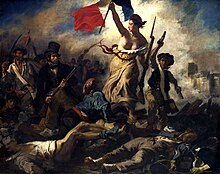
Just as Mannerism rejected Classicism, so did
Most artists attempted to take a centrist approach which adopted different features of Neoclassicist and Romanticist styles, in order to synthesize them. The different attempts took place within the French Academy, and collectively are called
In the early 19th century the face of Europe, however, became radically altered by
The response of architecture to industrialisation, in stark contrast to the other arts, was to veer towards historicism. Although the railway stations built during this period are often considered the truest reflections of its spirit – they are sometimes called "the cathedrals of the age" – the main movements in architecture during the Industrial Age were revivals of styles from the distant past, such as the
Time Period:
- Neoclassicism: mid-early 18th century to early 19th century
- Romanticism: late 18th century to mid-19th century
- Realism: 19th century
Modern art
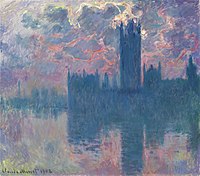

Out of the naturalist ethic of Realism grew a major artistic movement, Impressionism. The Impressionists pioneered the use of light in painting as they attempted to capture light as seen from the human eye. Edgar Degas, Édouard Manet, Claude Monet, Camille Pissarro, and Pierre-Auguste Renoir, were all involved in the Impressionist movement. As a direct outgrowth of Impressionism came the development of Post-Impressionism. Paul Cézanne, Vincent van Gogh, Paul Gauguin, Georges Seurat are the best known Post-Impressionists.
Following the Impressionists and the
Surrealism is often classified as a form of Modern Art. However, the Surrealists themselves have objected to the study of surrealism as an era in art history, claiming that it oversimplifies the complexity of the movement (which they say is not an artistic movement), misrepresents the relationship of surrealism to aesthetics, and falsely characterizes ongoing surrealism as a finished, historically encapsulated era. Other forms of Modern art (some of which border on Contemporary art) include:
- Abstract expressionism
- Art Deco
- Art Nouveau
- Bauhaus
- Color Field painting
- Conceptual Art
- Constructivism
- Cubism
- Dada
- Der Blaue Reiter
- De Stijl
- Die Brücke
- Body Art
- Expressionism
- Fauvism
- Fluxus
- Futurism
- Happening
- Surrealism
- Lettrisme
- Lyrical Abstraction
- Land Art
- Minimalism
- Naive art
- Op art
- Performance art
- Photorealism
- Pop art
- Suprematism
- Video art
- Vorticism
Time Period:
- Impressionism: late 19th Century
- Others: First half of the 20th century
Contemporary art and Postmodern art

Modern art foreshadowed several characteristics of what would later be defined as postmodern art; as a matter of fact, several modern art movements can often be classified as both modern and postmodern, such as pop art. Postmodern art, for instance, places a strong emphasis on irony, parody and humour in general; modern art started to develop a more ironic approach to art which would later advance in a postmodern context. Postmodern art sees the blurring between the high and fine arts with low-end and commercial art; modern art started to experiment with this blurring.[39] Recent developments in art have been characterised by a significant expansion of what can now deemed to be art, in terms of materials, media, activity and concept. Conceptual art in particular has had a wide influence. This started literally as the replacement of concept for a made object, one of the intentions of which was to refute the commodification of art. However, it now usually refers to an artwork where there is an object, but the main claim for the work is made for the thought process that has informed it. The aspect of commercialism has returned to the work.
There has also been an increase in art referring to previous movements and artists, and gaining validity from that reference.
Postmodernism in art, which has grown since the 1960s, differs from Modernism in as much as Modern art movements were primarily focused on their own activities and values, while Postmodernism uses the whole range of previous movements as a reference point. This has by definition generated a relativistic outlook, accompanied by irony and a certain disbelief in values, as each can be seen to be replaced by another. Another result of this has been the growth of commercialism and celebrity. Postmodern art has questioned common rules and guidelines of what is regarded as 'fine art', merging low art with the fine arts until none is fully distinguishable.[40][41] Before the advent of postmodernism, the fine arts were characterised by a form of aesthetic quality, elegance, craftsmanship, finesse and intellectual stimulation which was intended to appeal to the upper or educated classes; this distinguished high art from low art, which, in turn, was seen as tacky, kitsch, easily made and lacking in much or any intellectual stimulation, art which was intended to appeal to the masses. Postmodern art blurred these distinctions, bringing a strong element of kitsch, commercialism and campness into contemporary fine art;[39] what is nowadays seen as fine art may have been seen as low art before postmodernism revolutionised the concept of what high or fine art truly is.[39] In addition, the postmodern nature of contemporary art leaves a lot of space for individualism within the art scene; for instance, postmodern art often takes inspiration from past artistic movements, such as Gothic or Baroque art, and both juxtaposes and recycles styles from these past periods in a different context.[39]
Some
and various other important and influential painterly directions.See also
- History of art
- History of painting
- Lives of the Most Excellent Painters, Sculptors, and Architects (16th century book)
- Modernism
- Painting in the Americas before European colonization
- Western European paintings in Ukrainian museums
- List of time periods
References
- ^ a b Oosterbeek, Luíz. "European Prehistoric Art". Europeart. Retrieved 4 December 2012.
- ISBN 0198143869
- Banister Fletcherexcluded nearly all Baroque buildings from his mammoth tome A History of Architecture on the Comparative Method. The publishers eventually rectified this.
- ISBN 978-0-500-20008-7. "...in 1855 we find, for the first time, the word 'Renaissance' used — by the French historian Michelet — as an adjective to describe a whole period of history and not confined to the rebirth of Latin letters or a classically inspired style in the arts."
- ^ Hause, S. & Maltby, W. (2001). A History of European Society. Essentials of Western Civilization (Vol. 2, pp. 245–246). Belmont, CA: Thomson Learning, Inc.
- ^ a b "Art of Europe". Saint Louis Art Museum. Slam. Retrieved 4 December 2012.
- ^ Oosterbeek, Luíz. "European Prehistoric Art". Europeart. Retrieved 4 December 2012.
- ^ Sandars, 8-16, 29-31
- ^ Hahn, Joachim, "Prehistoric Europe, §II: Palaeolithic 3. Portable art" in Oxford Art Online, accessed 24 August 2012; Sandars, 37-40
- ^ Sandars, 75-80
- ^ Sandars, 253-257, 183-185
- ^ Kwong, Matt. "Oldest cave-man art in Europe dates back 40,800 years". CBC News. Retrieved 4 December 2012.
- ^ "Romanian Cave May Boast Central Europe's Oldest Cave Art | Science/AAAS | News". News.sciencemag.org. 21 June 2010. Retrieved 25 August 2013.
- ^ Gunther, Michael. "Art of Prehistoric Europe". Retrieved 4 December 2012.
- ^ Chaniotis, Angelos. "Ancient Crete". Oxford Bibliographies. Oxford University Press. Retrieved 2 January 2013.
- ^ Hood, 56
- ^ Hood, 17-18, 23-23
- ^ Hood, 240-241
- ^ Gates (2004), 33-34, 41
- ^ eg Hood, 53, 55, 58, 110
- ^ Chapin, 49-51
- ^ Hood, 37-38
- ^ Hood, 56, 233-235
- ^ Hood, 235-236
- ISBN 978-1-78274-748-2.
- ^ "Roman Painting". Art-and-archaeology.com. Retrieved 25 August 2013.
- ^ "Roman Painting". Heilbrunn Timeline of Art History. The Metropolitan Museum of Art. Retrieved 19 October 2013.
- ^ "The Vitruvian Man". leonardodavinci.stanford.edu. Retrieved 25 March 2018.
- ^ a b "BBC - Science & Nature - Leonardo - Vitruvian man". www.bbc.co.uk. Retrieved 25 March 2018.
- ISBN 978-0-7148-7502-6.
- ISBN 978-0-7148-7502-6.
- ISBN 978-0-7148-7502-6.
- ISBN 978-0-7148-7502-6.
- ^ a b "Baroque Art". Arthistory-famousartists-paintings.com. 24 July 2013. Retrieved 25 August 2013.
- ^ "Ancien Regime Rococo". Bc.edu. Archived from the original on 11 April 2018. Retrieved 25 August 2013.
- ^ "chinoiserie facts, information, pictures - Encyclopedia.com articles about chinoiserie". www.encyclopedia.com. Retrieved 25 March 2018.
- ^ "Art in Neoclassicism". Artsz.org. 26 February 2008. Retrieved 25 August 2013.
- ^ Tim Blanning and Hagen Schulze(New York: Oxford University Press, 2006), 5-18.
- ^ a b c d e f "General Introduction to Postmodernism". Cla.purdue.edu. Retrieved 25 August 2013.
- ^ Ideas About Art, Desmond, Kathleen K. [1] Archived 29 October 2022 at the Wayback Machine John Wiley & Sons, 2011, p.148
- ^ International postmodernism: theory and literary practice, Bertens, Hans [2] Archived 29 October 2022 at the Wayback Machine, Routledge, 1997, p.236
- ^ M. Rowell, Joan Mirό: Selected Writings and Interviews (London: Thames & Hudson, 1987) pp. 114–116.
Bibliography
- Chapin, Anne P., "Power, Privilege and Landscape in Minoan Art", in Charis: Essays in Honor of Sara A. Immerwahr, Hesperia (Princeton, N.J.) 33, 2004, ASCSA, ISBN 0876615337, 9780876615331, google books
- Gates, Charles, "Pictorial Imagery in Minoan Wall Painting", in Charis: Essays in Honor of Sara A. Immerwahr, Hesperia (Princeton, N.J.) 33, 2004, ASCSA, ISBN 0876615337, 9780876615331, google books
- ISBN 0140561420
- Sandars, Nancy K., Prehistoric Art in Europe, Penguin (Pelican, now Yale, History of Art), 1968 (nb 1st edn.; early datings now superseded)









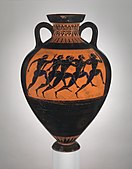

![The Parthenon on the Athenian Acropolis, the most iconic Doric Greek temple built of marble and limestone between circa 460-406 BC, dedicated to the goddess Athena[25]](http://upload.wikimedia.org/wikipedia/commons/thumb/8/8f/The_Parthenon_from_the_northeast.%2C_Acropolis_of_Athens_%2813896193092%29.jpg/170px-The_Parthenon_from_the_northeast.%2C_Acropolis_of_Athens_%2813896193092%29.jpg)










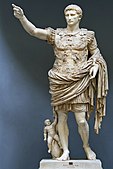




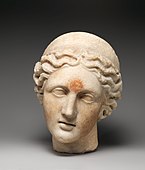
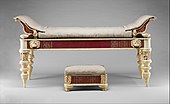

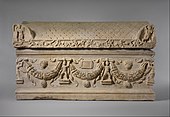




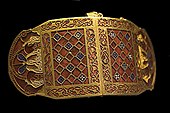



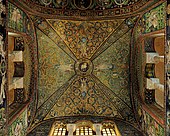





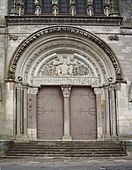


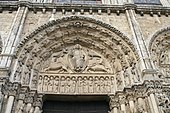






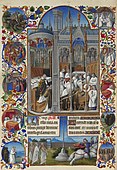
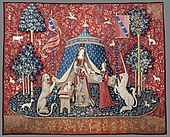
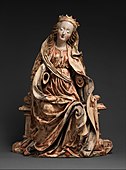

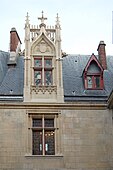
![Pulpit in the Pisa Baptistery by Nicola Pisano; 1260; marble; height: 4.6 m.[31]](http://upload.wikimedia.org/wikipedia/commons/thumb/b/be/Pisa%2C_battistero_di_San_Giovanni_%2845%29.jpg/120px-Pisa%2C_battistero_di_San_Giovanni_%2845%29.jpg)
![Crucifix; by Cimabue; circa 1285; tempera on panel; 4.29 x 3.83 m; San Domenico (Arezzo, Italy)[32]](http://upload.wikimedia.org/wikipedia/commons/thumb/b/bb/CrocifissoCimabue-Arezzo-Photo_taken_by_Senet._April_20%2C_2010-Perspective_correction%2C_crop_and_blackframe_with_GIMP_by_Paolo_Villa_2019.jpg/138px-CrocifissoCimabue-Arezzo-Photo_taken_by_Senet._April_20%2C_2010-Perspective_correction%2C_crop_and_blackframe_with_GIMP_by_Paolo_Villa_2019.jpg)
![Crucifix; Giotto; circa 1300; tempera on panel; 5.78 x 4.06 m; Santa Maria Novella (Florence, Italy)[33]](http://upload.wikimedia.org/wikipedia/commons/thumb/c/c0/Giotto._the-crucifix-1290-1300_Florence%2C_Santa_Maria_Novella.jpg/129px-Giotto._the-crucifix-1290-1300_Florence%2C_Santa_Maria_Novella.jpg)












